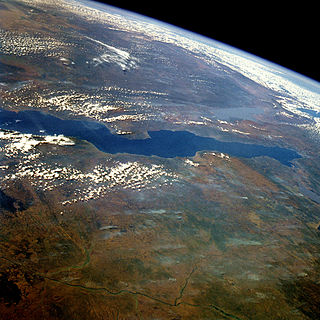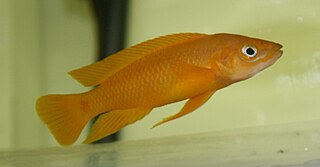
Lake Tanganyika is an African Great Lake. It is the second-oldest freshwater lake in the world, the second-largest by volume, and the second-deepest, in all cases after Lake Baikal in Siberia. It is the world's longest freshwater lake. The lake is shared among four countries—Tanzania, the Democratic Republic of the Congo (DRC), Burundi, and Zambia, with Tanzania (46%) and DRC (40%) possessing the majority of the lake. It drains into the Congo River system and ultimately into the Atlantic Ocean.

The terms shell dwellers or shelldwellers, shell-breeding, or ostracophil are descriptive terms for cichlid fish that use the empty shells of aquatic snails as sites for breeding and shelter. The terms have no taxonomic basis, although most shell-dwelling cichlids are from Lake Tanganyikas lamprologine lineage. Many shell dwelling cichlids are popular with fishkeepings and are frequently kept in aquaria.

Neolamprologus brichardi is a species of cichlid endemic to the alkaline waters of Lake Tanganyika in East Africa. It is a popular aquarium fish kept in the fishkeeping hobby, where it is known under a variety of common names including Princess cichlid, Princess of Burundi, Lyretail cichlid, Fairy cichlid and Brichard's lamprologus. In addition, the species is also the subject of numerous studies on fish behaviour. It is closely related to N. pulcher from the southern half of Lake Tanganyika and some have recommended merging the two into a single species.

Variabilichromis moorii has no common name and is a species of freshwater cichlid endemic to Lake Tanganyika in eastern Africa. It is a small ovate bodied fish named for an early collector of fish from the lake, John Edmund Sharrock Moore (1870-1947) who was a cytologist, zoologist and led an expedition to Lake Tanganyika and who discovered this species. Juveniles are usually yellow, and adults are dark brown to black in color. It reaches a total length (TL) of 10.3 centimetres (4.1 in). Currently it is the only member of its genus. V. moorii feeds on algae, zooplankton, and benthic invertebrates. It is also found in the aquarium trade.

Neolamprologus is a genus of cichlids endemic to eastern Africa with all but one species, Neolamprologus devosi from the Malagarasi River, occurring in Lake Tanganyika. It is the largest genus of cichlids in Lake Tanganyika and also the largest genus in the tribe Lamprologini, which includes Altolamprologus, Chalinochromis, Julidochromis, Lamprologus, Lepidiolamprologus, Telmatochromis and Variabilichromis. The latter is a monotypic genus doubtfully distinct from Neolamprologus.

Neolamprologus multifasciatus is one of the small shell-dwelling cichlids endemic to Lake Tanganyika. The male reaches 5 cm (2 in) in length, and the female only 2.5 cm (1 in) in the aquarium. In the wild, they reach only 3 centimetres (1.2 in) in standard length of male and female reaches less than 2.2 centimetres (0.87 in) in standard length. This makes them one of the smallest cichlid species in the world. Its natural habitat is the Neothauma shell beds of Lake Tanganyika, where it forms huge colonies with thousands of individuals. Their unique behavior is associated with their affinity to shells. They burrow sand to move shells, take refuge in shells and also breed in them. They have pale white coloring with black vertical bars running the length of their bodies. The species is sexually monomorphic, meaning sexing individuals is extremely hard or impossible based on external appearance alone.

Neolamprologus leleupi is a species of cichlid endemic to Lake Tanganyika where it occurs throughout the lake. It is a recess-dweller, inhabiting cracks and crevices. It feeds on invertebrates living in the rich biocover of the substrate. This species reaches a length of 10 centimetres (3.9 in) TL. The color of this fish ranges from bright yellow to deep brown. Both color variations exist at each location where this species is found. This relatively small cichlid is a substrate spawner. It is easily confused with the very similar N. longior a fish also endemic to Lake Tanganyika. The specific name honours the Belgian entomologist Narcisse Leleup (1912-2001), who collected the type.

Lepidiolamprologus boulengeri is a species of cichlid endemic to Lake Tanganyika where it is known from the Tanzanian coast in the northern part of the lake. Pairs of this species live together in their territory and the female lives in snail shells in a pit that they have dug in the sand. This species can reach a length of 6.2 centimetres (2.4 in) TL. This species can also be found in the aquarium trade.
Neolamprologus buescheri is a species of cichlid endemic to Lake Tanganyika. This species can reach a length of 8 centimetres (3.1 in) TL. It can also be found in the aquarium trade. The specific name of this cichlid honours the collector of its type, the German ichthyologist Heinz H. Büscher.
Neolamprologus christyi is a species of cichlid endemic to Lake Tanganyika. This species can reach a length of 13.7 centimetres (5.4 in) TL. It can also be found in the aquarium trade. This cichlid's specific name honours the British naturalist and explorer Cuthbert Christy (1863-1932) who worked for the Belgian Governemant and who collected the type in either 1926 or 1927.

Neolamprologus fasciatus is a species of cichlid endemic to Lake Tanganyika. This species spawns in empty snail shells. This species can reach a length of 15 centimetres (5.9 in) TL. This species can also be found in the aquarium trade. They are piscivores and their prey includes the cichlid fish Variabilichromis moorii.
Neolamprologus leloupi is a species of cichlid endemic to Lake Tanganyika. This species reaches a length of 6.1 centimetres (2.4 in) TL. It can also be found in the aquarium trade. The specific name honours the malacologist Eugène Leloup (1902-1981), chief of the Belgian Hydrobiological Mission to Lake Tanganyika in 1946–1947, the type being collected during this expedition.

Neolamprologus mondabu is a species of cichlid endemic to Lake Tanganyika except for the southern portion where it is replaced by N. modestus. It prefers areas with rocky substrates, moving to areas with sandy substrates to breed. It feeds on the eggs of Lamprichthys tanganicanus. This species can reach a length of 10.7 centimetres (4.2 in) TL. This species can also be found in the aquarium trade.
Neolamprologus mustax is a species of cichlid endemic to Lake Tanganyika. This species reaches a length of 9 centimetres (3.5 in) TL. It can also be found in the aquarium trade. Individuals are yellow in color and thus resemble juveniles of another cichlid species, Variabilichromis moorii, which may provide N. mustax with greater access to V. moorii feeding territories.
Neolamprologus pleuromaculatus is a species of cichlid endemic to Lake Tanganyika where it is only known to occur in the northern half of the lake. This species can reach a length of 12 centimetres (4.7 in) TL. It can also be found in the aquarium trade.
Neolamprologus savoryi is a species of cichlid endemic to Lake Tanganyika. This species reaches a length of 8 centimetres (3.1 in) TL. It can also be found in the aquarium trade. The specific name of this cichlid honours Bryan Wyman Savory (1904-1988) who was the District Commissioner of Kigoma in the Tanganyika Territory during the Belgian Hydrobiological Mission to Lake Tanganyika of 1946–1947, this expedition collected the type.

Neolamprologus tretocephalus is a species of cichlid endemic to Lake Tanganyika where it is found in sandy areas in the northern half of the lake. It is a predator on molluscs. This species can reach a length of 15 centimetres (5.9 in) TL. This species can also be found in the aquarium trade.
Neolamprologus toae is a species of cichlid endemic to Lake Tanganyika. This species reaches a length of 12 centimetres (4.7 in) TL. It can also be found in the aquarium trade.

Lamprologini is a tribe of African cichlid fishes. It contains seven genera and nearly 100 species. Over half of the species in this tribe are in the large genus Neolamprologus. Most genera in the tribe are endemic to Lake Tanganyika, but one species of Neolamprologus is from the Malagarasi River in Tanzania, and several species of Lamprologus are from the Congo River Basin.
Neolamprologus cancellatus is a species of cichlid endemic to Lake Tanganyika where it is usually found in the Wonzye Point area of Zambia. This species can reach a length of 5.7 centimetres (2.2 in) TL. This species can also be found in the aquarium trade.










